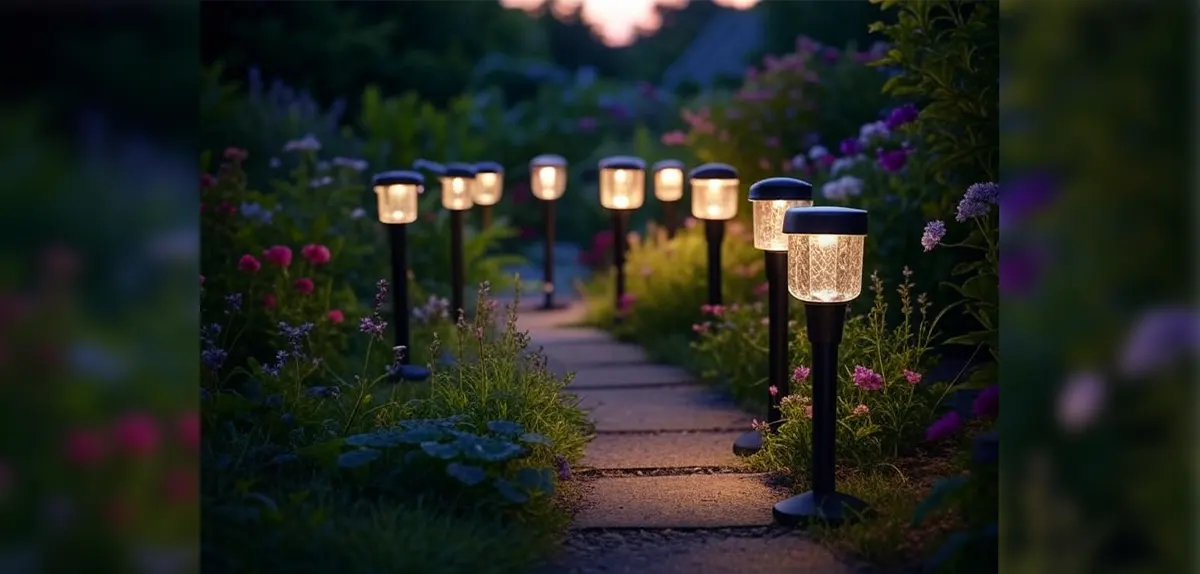So how long do solar lights actually last?
Solar lights, like most rechargeable products, eventually run out of power and must be recharged. But how long do solar lights last? Unlike most rechargeable products, solar lights can be exposed to sunlight during the day in order to provide lighting at night. Sunlight that reaches the solar panels generates electricity that is stored into the solar light batteries, and is used once it is dark outside. The batteries in solar lights typically last for 2 years before they have to be replaced, as they are no longer able to hold enough energy to provide lighting.
Replacement Batteries
Replacement batteries can be purchased to be installed within solar lights to avoid purchasing new lights. The light is produced from LEDs, which can last upwards of 30 years. So you don’t need to worry about them as much.

![]() Solar lights work best if they are placed in direct sunlight away from shadows to get a full charge, which usually takes between 4 to 12 hours. The batteries in solar lights provide enough energy to allow lighting all evening. Solar lights provide illumination once they detect low levels of light, generally after sunset.
Solar lights work best if they are placed in direct sunlight away from shadows to get a full charge, which usually takes between 4 to 12 hours. The batteries in solar lights provide enough energy to allow lighting all evening. Solar lights provide illumination once they detect low levels of light, generally after sunset.
Solar Lights In Your Garden
Most solar lights are placed around gardens to show the outline of the garden at night, and help prevent people from stepping on gardens in the dark. Sometimes, lights that are placed here become dirty, making it difficult for the lights to receive enough power. Make sure to check them every couple months to ensure the panels are clean of dirt and still receiving sunlight. Related Article: Best Solar Flagpole Light
Cold Temperature Effect
Solar lights are not well equipped to handle snow and freezing temperatures, and are best stored inside during the colder winter months. Solar lights will often be covered in snow, making it difficult for them to maintain a charge. Cold temperatures can also affect the lifetime of the battery, and less daylight/longer nights can affect how long lighting can be provided.
Year Round-Solar Light
If you live in a more temperate climate, solar lights can work year-round. However, winter typically has shorter days and longer nights, reducing the amount of time that solar lights will be able to provide illumination. If you find that there are seasons with more rain than others, they might have a lower ability to be fully charged, reducing the amount of illumination that can be provided. Related Article: Best Solar Lamp Post
Solar Shed Lights
Looking for the best solar shed lights? Check our latest review here.
Solar Walkway Lights
Ultimately, choosing the right solar light for the right application is the best way to get value from your purchase. Determining what kind of lighting modes you need, along with how bright they need to be and how many lights will be needed to meet your lighting needs are important considerations that should go into purchasing solar lights. Our solar lantern article showcases the best solar lanterns for outdoors, home lighting and commercial applications. We identify lights that are designed to last, and provide specific lighting needs. Check out our buyer’s guide to learn more about the specifics of solar lighting. 
Tip# 1
Well maintained solar lights can last for a long time if you keep in mind a couple things. Cleaning the solar panels frequently, replacing batteries if solar lights are unable to provide 8 hours of illumination, and storing solar lights indoors when it’s your winter/rainy season. These are all good practices to extend the lifetime of your solar lights.
Tip# 2
Avoid placing solar lights in areas with street lighting or house lights in order for them to detect low levels of light, allowing them to provide illumination. Most solar lights are placed around gardens to show the outline of the garden at night, and help prevent people from stepping on gardens in the dark. Sometimes, lights that are placed here become dirty, making it difficult for the lights to receive enough power.
Tip# 3
Solar lights that are placed in gardens would benefit from being placed around the perimeter in order to avoid being covered by plants, minimizing the amount of dirt that accumulates on the panels.
Tip# 4
Regular cleaning of the panels allows them to produce the maximum amount of energy, leading to longer hours of illumination. Wiping the panel surface with a clean cloth every two weeks is the best way to make sure that the solar lights are performing at their best.
Tip# 5
Storing lights inside in cold winters prolongs the lifetime of the battery. Store solar lights in areas where they receive either sunlight or house lighting in order to allow the battery to maintain a charge.
Tip# 6
Switch the lights to the off position when there are long periods of rain or cloud in the forecast to extend the lifetime of the battery. Solar lights that have glass can be damaged by extreme wind storms, and should be stored inside to protect them.
Learn about solar panel angles and what angle is best
The angle that your solar panels are facing is important in order to maximize the amount of energy they produce. There are a lot of factors that go into determining which angle should be best for you, but some general guidelines can help simplify things.
Another handy solar invention is the solar pool cover, check out our article for more information about it!


2 Comments
Pingback: How To Fix Solar Lights? Guide To Troubleshooting/Disassembly
Pingback: Best Outdoor Solar Lights 2019 | Reviews and Buying Guide | Best Home Gear